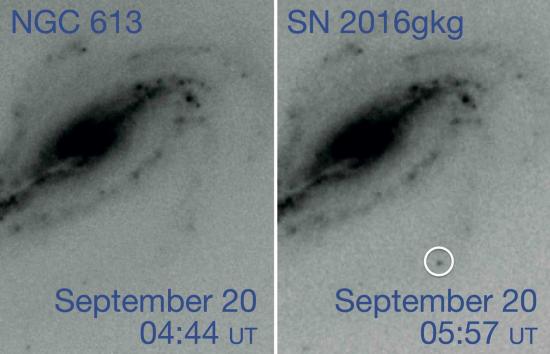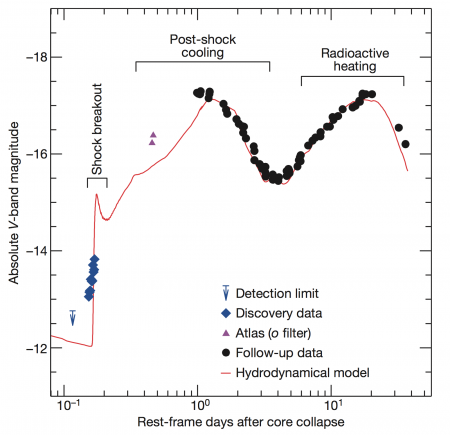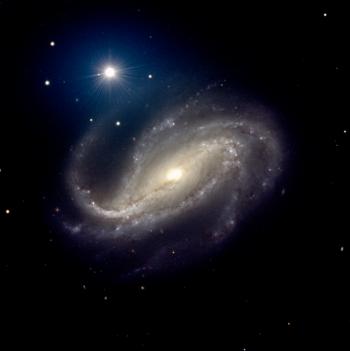An unprecedented observation of a supernova, an explosion of a massive star, was captured in its early days by an amateur astronomer, at the exact moment when the supernova became visible in the sky. These early data and additional observations obtained by a battery of telescopes enabled a team of researchers from several institutes of CONICET [1], in Argentina, and the Astrophysics Department-AIM Laboratory (CEA-CNRS-University Paris Diderot) in France, to test for the first time theoretical predictions about the initial evolution of such stellar explosions. These results are published in the journal Nature of February 22, 2018.
A luminous wave explodes at the surface
Until now purely theoretical, the supernova models indicate that the spectacular increase in the luminosity of a supernova was due to the emergence of a luminous wave, an explosive shock wave at the surface of the star. Such a phenomenon had been predicted for a long time and was actively sought by several groups of scientists around the world. But it is an amateur astronomer, lucky and very watchful, who managed to follow for the first time the evolution of the very first phases of this phenomenon.
On September 20, 2016, when Víctor Buso, a native of Rosario, Argentina, was testing a new telescope, only 40 centimeters in diameter, he noticed that a new, very dim object had appeared south of the center of the spiral galaxy NGC 613 , located in the constellation of the Sculptor, about 65 million light-years from Earth. Before his eyes, a supernova exploded. In less than half an hour, the object had multiplied its brightness by 3. If it was a first supernova discovery for this man but it was also a unique discovery among the thousands of such events detected each year.

The images taken by the amateur astronomer Víctor Buso show that in just over an hour (between 4:44 and 5:57 UTC), a super "new" star (supernova) appeared in the outer areas of the galaxy NGC 613 The increase of its luminosity could then be measured for the first time with precision, in this very early phase of the explosion of a massive star. Copyright V. Buso
Key early data for models
Announced and nicknamed SN 2016gkg, this supernova quickly attracted the attention of a team of researchers from CONICET in Argentina. "At first, we thought it was just a nice discovery made by an Argentinian amateur," says Dr. Melina Bersten from the Instituto de Astrofísica de La Plata (IALP-CONICET), who did the computer simulations. "But after reviewing what he saw, we realized it was very new."
The research team carefully analyzed the images and compared the increase in brightness with the predictions of their computer simulations. "To our surprise, the images were of high quality and the sky conditions were ideal for making such a discovery," notes Dr. Gastón Folatelli of IALP, who led the data analysis and adds "we could calculate that the first observations were obtained only 1 to 3 hours after the explosion, a crucial data for the models."
According to the models previously considered by the astrophysicists, the brutal and initial increase of the supernova light can be explained by the emergence of the shock, at the surface of the star. After analyzing the SN 2016gkg supernova, this hypothesis seems entirely corroborated. The models did not require any additional modification in order to reproduce in a coherent way the initial increase and the rest of the evolution of the supernova. The event 2016gkg is rather ordinary, which implies that the phase that is observed is probably common to all supernovas, as the models predict.

Variation over time (in logarithmic scale) of the suernova brightness of the supernova SN2016gkg (in magnitude, each increase of 2.5 magnitude corresponds to a flux 10 times higher). The discovery data, associated with those of the later monitoring, made it possible to show that the light curve of a supernova comprises not two peaks but three peaks: the peak due the emergence of the shock, the peak due to the dissipation of the energy of the shock and then later the peak due to the energy of the radioactive elements formed during the explosion. Copyright M.C. Bernsten
According to Federico García of the Argentino Institute of Radioastronomy (IAR-CONICET) and the AIM laboratory (Paris Diderot University, CEA, CNRS) who participated in the analysis and interpretation of these observations, "For the first time, this happy discovery has allowed astronomers to test the validity of their models in all their extent on real data ". The initial and rapid increase in brightness is well compatible with the phenomenon that marks the birth of the supernova. This is the exact moment when the blast wave of the explosion emerges from the stellar surface, after having traversed the supersonic interior of the star. At this very moment, a huge amount of light is violently released, in a flash of light. "What is remarkable is the fact that the theoretical models here are able to explain the results observed by Buso, without changing any hypothesis" says Federico García, adding "This event also proved that, even in the new era of large robotic surveys, vigilant amateur astronomers can provide invaluable data to the scientific community. " The results were published in Nature by the Argentine team and colleagues from Japan, USA, and Europe
Combining the different circumstances that led to this discovery, the rarity of supernovae (about one every hundred years in a galaxy), the brevity of the luminous increase (about an hour), the clarity of the sky needed and the location at outside the galaxy, the discovery of the amateur Victor Buso had a probability of occurring about one in a hundred million!
Contact : Federico García
Publication :
"A surge of light at the birth of a supernova"
M.C. Bersten et al. published in Nature on February 22th, 2018
http://dx.doi.org/10.1038/nature25151
See : - Paris-Diderot-CNRS-CEA Press release (8 Februrary 2018, in French)
See also : More than 10 revolutions per second at birth (23 June 2016)
[1] CONICET is the National Scientific and Technical Research Council of Argentina (Consejo Nacional de Investigaciones Científicas y Técnicas)
Content : Federico García, J.M. Bonnet-Bidaud




